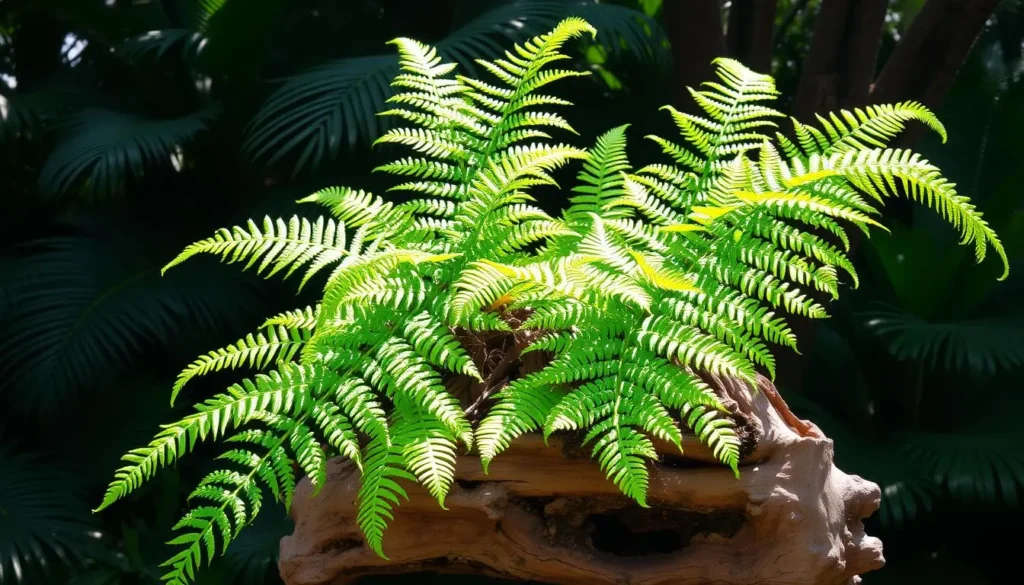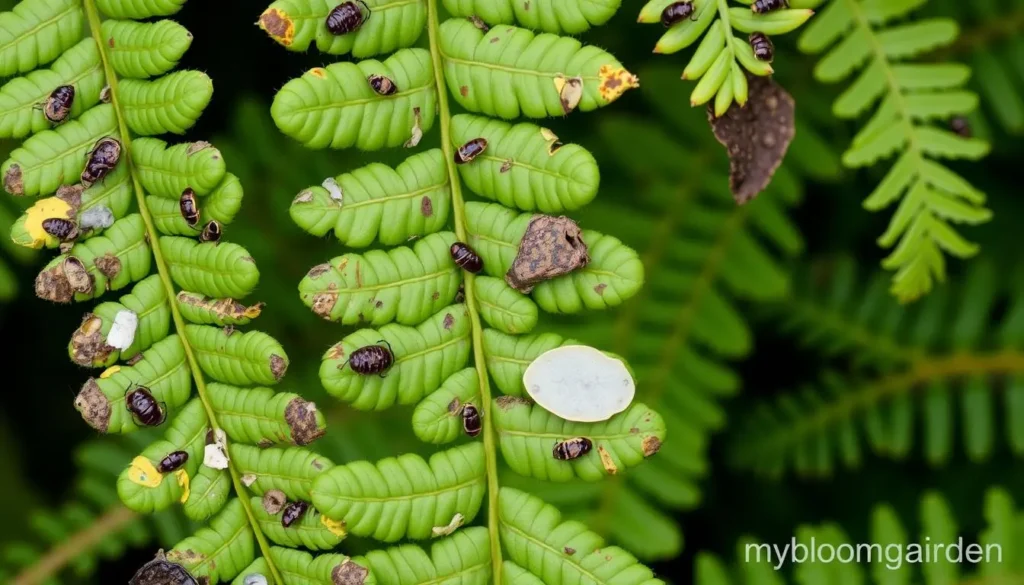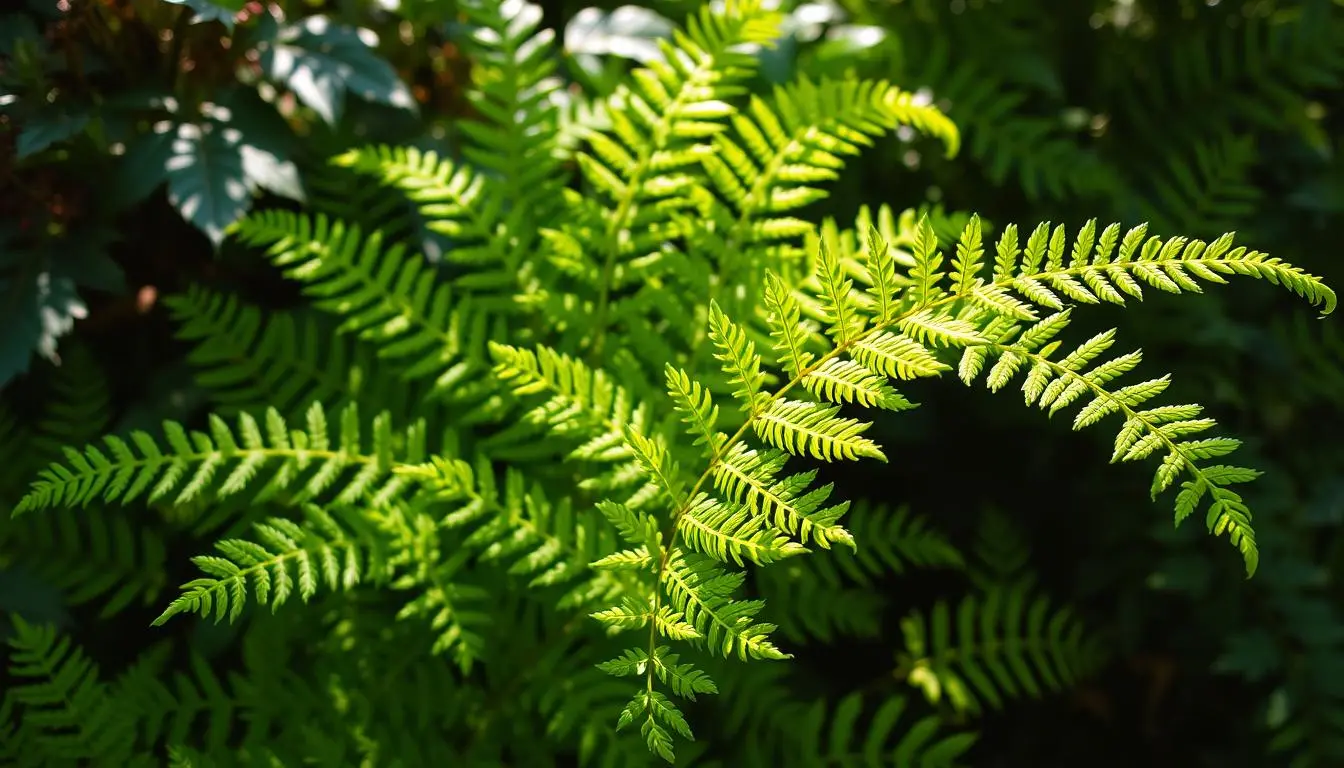I’ve always been drawn to the elkhorn fern’s unique look. These plants, with their antler-like fronds, bring elegance to any space. But, caring for them can be tricky. It needs the right environment and careful attention.
In this guide, I’ll share my knowledge. I’ll give you the key tips to make your elkhorn fern plant flourish. It will become a stunning part of your home or garden.
Table of Contents
Understanding the Elkhorn Fern Plant
The elkhorn fern is a plant that catches the eye. It has unique, antler-like fronds and grows on other plants. This makes it a favorite among gardeners and plant lovers.
Natural Habitat and Growth Patterns
The elkhorn fern comes from warm places like Southeast Asia and Australia. It grows on trees, getting its food and water from the air and nearby.
Different Varieties of Elkhorn Ferns
- Elkhorn fern (Platycerium bifurcatum)
- Black elkhorn fern (Platycerium superbum)
- Moulmein elkhorn fern (Platycerium wallichii)
- Philippine elkhorn fern (Platycerium coronarium)
Unique Characteristics and Features
The elkhorn fern’s fronds look like antlers and can grow big. They spread out in a fan shape. The plant has two types of fronds: ones that make spores and ones that help it stick to its host and keep moisture.
“The elkhorn fern’s unique and striking appearance makes it a truly remarkable addition to any indoor or outdoor plant collection.”
Essential Growing Requirements for Elkhorn Ferns
Want to grow a healthy elkhorn fern? Knowing the key growing needs is vital. These plants need the right light, temperature, humidity, and mounting. Meeting these needs will help your elkhorn fern thrive.
Light and Temperature Preferences
Elkhorn ferns love bright, indirect light. They do best in a spot with dappled sunlight all day. Direct sunlight can harm their leaves. Keep the temperature between 65°F and 80°F for best growth.
Mounting and Substrate
- Elkhorn ferns grow on trees naturally. You can mount them on bark, driftwood, or a strong board.
- Use a well-draining substrate like sphagnum moss or perlite. This prevents waterlogging and keeps moisture right.
By meeting the essential growing requirements for elkhorn ferns, you’ll create the best environment. Your elkhorn fern will flourish and show off its beautiful leaves.
“Elkhorn ferns are a fascinating addition to any indoor or outdoor plant collection, but they do require specific care to reach their full potential.”
Light and Temperature Requirements
For the elkhorn fern plant to grow well, it needs the right light and temperature. These ferns prefer bright, indirect light, similar to their natural home.
Optimal Light Conditions
Elkhorn ferns thrive in bright, indirect sunlight. Position your plant near a window that gets lots of natural light. If you don’t have enough natural light, use artificial lighting for 12-14 hours a day.
Temperature Range for Healthy Growth
Elkhorn ferns grow best in temperatures between 65-75°F (18-24°C). Keep your plant away from extreme temperature changes. This helps prevent stress and keeps your fern healthy.
Protecting from Temperature Extremes
Keep your elkhorn fern away from air conditioning vents and drafts. In winter, move it to a warmer spot to avoid cold damage. Regularly check and adjust your plant’s environment to ensure it thrives.
Consistent monitoring and gradual adjustments are key to maintaining the right light and temperature balance for your elkhorn fern’s optimal growth and health.
Soil and Mounting Options
Choosing the right soil and mounting options is key for healthy elkhorn ferns. These plants grow on other plants or surfaces, not in soil. This means you need a special approach to help them thrive.
Attaching the fern to wood or bark is a popular choice. It mimics their natural habitat and provides the needed support and air. You can use cork, tree fern fiber, or driftwood for mounting.
- Cork: Offers great drainage and air circulation, perfect for elkhorn fern care.
- Tree fern fiber: A natural material that helps keep moisture and nutrients.
- Driftwood: Adds a natural touch and supports the fern.
For soil, a mix made for epiphytic plants is best. It should have sphagnum moss, perlite, and bark chips. These ingredients help keep the right moisture and air balance.
“Recreating the natural growing conditions of elkhorn ferns is key to their successful cultivation.”
If you grow your fern in a pot, make sure it has good drainage. This prevents waterlogging and lets the roots breathe.

By picking the right mounting and soil, you’ll create a great home for your elkhorn fern. Enjoy its beautiful foliage for many years.
Watering Schedule and Humidity Needs
Keeping the right watering schedule and humidity levels is key for your elkhorn fern’s health. Getting these right can greatly help your fern thrive at home or in your garden.
Proper Watering Techniques
Elkhorn ferns like their soil moist but not too wet. Water when the top inch of soil feels dry. Don’t let the soil dry out completely, as it can stress the plant and cause frond loss. Use a spray bottle or a watering can with a fine mist to gently water without harming the fronds.
Maintaining Ideal Humidity Levels
Elkhorn ferns do best in humid places. Try to keep the humidity around 50-70% near your plant. To boost humidity, you can:
- Place a pebble tray filled with water near the plant
- Use a humidifier in the room
- Mist the fronds regularly with a spray bottle
Signs of Improper Watering
Watch for signs that your elkhorn fern might be getting too much or too little water. Yellow or brown fronds, wilting, or a mushy base mean it’s getting too much water. On the other hand, dry, crisp fronds suggest it’s not getting enough. Adjust your watering to keep your fern healthy and happy.
Fertilizing Your Elkhorn Fern Plant
Keeping your elkhorn fern plant healthy means the right food. These plants need special nutrients to grow well at home or in your garden.
Timing is everything when you fertilize your elkhorn fern. Spring and summer are the best times. This is when the plant grows the most and needs extra nutrients.
Use a balanced, water-soluble fertilizer made for ferns or epiphytes. Look for a mix with about 20-20-20 or 10-10-10. This gives the right amounts of nitrogen, phosphorus, and potassium. But, use half the amount suggested to avoid harming your plant.
- Apply the fertilizer every 2-3 months during the growing season.
- Avoid fertilizing during the fall and winter when the plant is dormant.
- Always water the plant thoroughly before and after applying the fertilizer.
With the right food and care, your elkhorn fern will stay healthy and vibrant. It will thrive for many years.
Pruning and Maintenance Tips
To keep your elkhorn fern healthy and vibrant, a bit of pruning and regular care is needed. Follow these simple tips to ensure your plant thrives and looks stunning.
Removing Dead Fronds
As time goes by, older fronds of your elkhorn fern may turn discolored, dry, or damaged. It’s crucial to remove these to encourage new growth and keep your plant looking great. Gently pull the frond from the base, avoiding cuts to the rhizome to prevent stunted growth.
Shaping and Training Techniques
Elkhorn ferns grow naturally but can get unruly if not managed. Use gentle training to keep your plant tidy and aesthetically pleasing. Softly guide the fronds with plant ties or clips to help it grow compactly and symmetrically.
Regularly check your elkhorn fern, removing dead or damaged fronds, and lightly shape it. This care will keep your plant thriving and adding beauty to your space. By following these how to care for elkhorn fern tips, you can enjoy your growing elkhorn ferns for many years.
“The key to maintaining a healthy and vibrant elkhorn fern is to stay on top of regular pruning and shaping. It’s a labor of love, but the results are well worth it.”
Common Pests and Diseases
Keeping your elkhorn fern healthy is key to its success. These plants can face common pests and diseases. Knowing the risks and taking action early can help your fern stay vibrant.
Pests to Watch Out For
- Spider Mites – These tiny arachnids can quickly infest your elkhorn fern, causing webbing, discoloration, and stunted growth. Regular misting and insecticidal soap can help control spider mite populations.
- Mealybugs – The waxy, cottony appearance of mealybugs is a telltale sign of their presence. They feed on the plant’s sap, leading to yellowing and wilting. Use a cotton swab dipped in rubbing alcohol to remove mealybugs manually.
- Scale Insects – Scale insects attach themselves to the fronds and stems, secreting a protective shell that makes them difficult to remove. Horticultural oil or insecticidal soap can help eliminate scale infestations.
Diseases to Be Aware Of
- Root Rot – Caused by overwatering or poor drainage, root rot can quickly weaken and kill your elkhorn fern. Ensure the plant is in well-draining soil and allow the medium to dry out slightly between waterings.
- Leaf Spot – Various fungal and bacterial diseases can cause unsightly spots or discoloration on the fronds. Improving air circulation and reducing humidity can help prevent and manage leaf spot issues.
- Frond Necrosis – If the tips or edges of the fronds start turning brown and dying, it could be a sign of environmental stress or nutrient deficiency. Adjusting growing conditions and providing appropriate fertilization can help address this problem.
By staying vigilant and addressing any pest or disease issues promptly, you can maintain the health and beauty of your elkhorn fern for years to come. With the right elkhorn fern care and proactive measures, you can ensure your plant thrives and continues to be a stunning addition to your indoor or outdoor landscape.

Propagation Methods and Techniques
Expanding your collection of elkhorn fern plants is rewarding. There are several effective ways to do it. You can choose from simple division or the detailed spore propagation. Knowing these methods helps you grow and share these unique ferns.
Division of Plantlets
One easy way to propagate elkhorn ferns is by dividing plantlets. These small plants grow along the mother plant’s rhizome. Carefully remove the plantlet, making sure it has its own roots. Then, transplant it into its own container or spot.
Spore Propagation Steps
- Collect mature spores from the underside of the elkhorn fern’s fronds.
- Sterilize a planting medium, such as sphagnum moss or a mix of peat and perlite.
- Spread the spores evenly over the medium and cover with a clear plastic lid or bag to keep humidity in.
- Put the container in a warm, indirect light spot and watch for small prothalli growth.
- When the prothalli mature, move them to individual containers or attach them to a surface.
Choosing the right propagation method is important. Patience and attention to detail are crucial for growing new elkhorn fern plants. With care and a bit of experimentation, you can grow and share these unique ferns.
Troubleshooting Growing Problems
Growing an elkhorn fern can be rewarding but comes with challenges. If your plant’s growth or health is a problem, don’t worry. Simple solutions often fix these issues. Here are some common tips to keep your elkhorn fern healthy.
Yellowing or Browning Fronds
Yellow or brown fronds on your elkhorn fern might mean a few things. It could be from too much water, too little water, or too much sunlight. Check your care routine and make sure you’re giving the right amount of moisture and light.
Stunted Growth
If your elkhorn fern isn’t growing fast enough, it might need more nutrients or better conditions. Make sure you’re using the right fertilizer. Also, keep the temperature and humidity just right for your plant.
Pest Infestations
Pests like mealybugs, scale insects, or spider mites can harm your elkhorn fern. Check your plant closely and act fast to get rid of pests. Try to use organic pest control methods.
“The key to successfully troubleshooting your elkhorn fern is to address issues early and with a gentle, attentive approach. These plants are resilient, but they do require some TLC to thrive.”
By watching your plant closely and fixing problems early, you can keep your elkhorn fern healthy. This way, it will continue to add beauty to your home. A little effort in troubleshooting can make a big difference in your elkhorn fern’s health.
Conclusion
Congratulations on exploring the world of growing elkhorn fern plants! You now know how to grow healthy, lush elkhorn ferns at home or in your garden. This guide has given you the tools to care for your elkhorn fern plant, whether you’re new to gardening or have experience.
You’ve learned about elkhorn ferns’ unique traits and how to meet their needs for light, temperature, soil, water, and fertilizer. Keep an eye out for pests and diseases. If problems come up, you know how to fix them.
Start your elkhorn fern growing adventure with excitement. Use what you’ve learned to enjoy a beautiful, green elkhorn fern for years. Happy growing!

